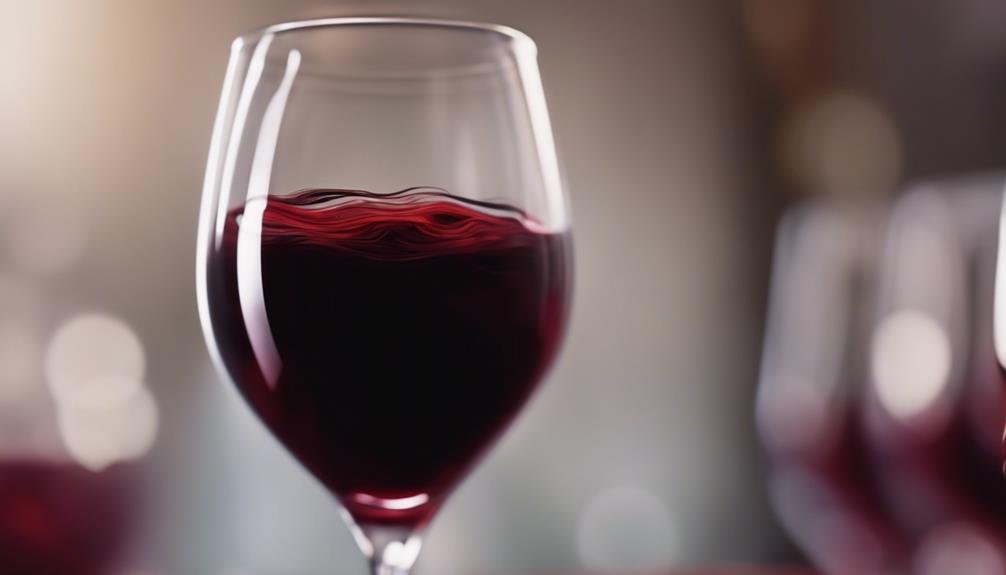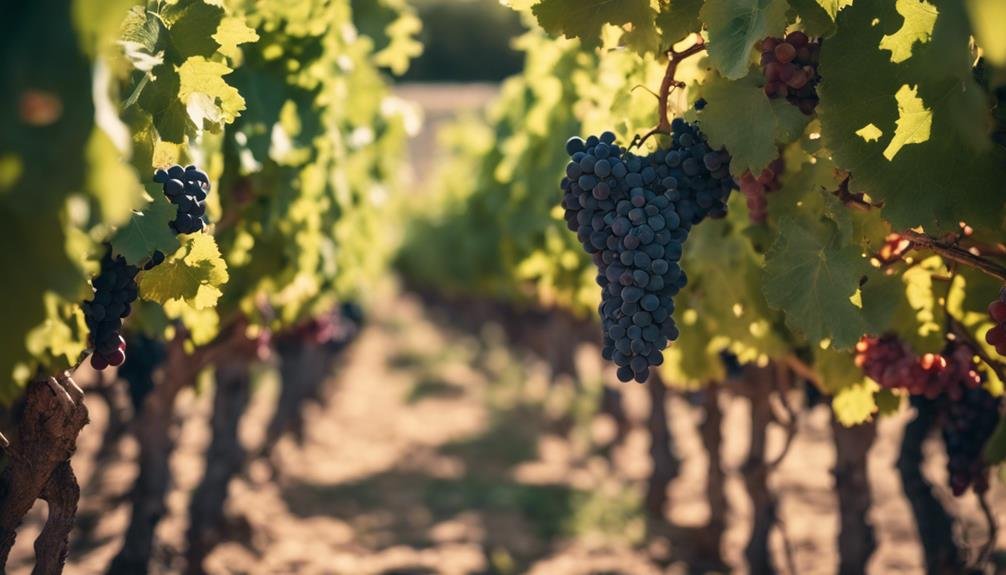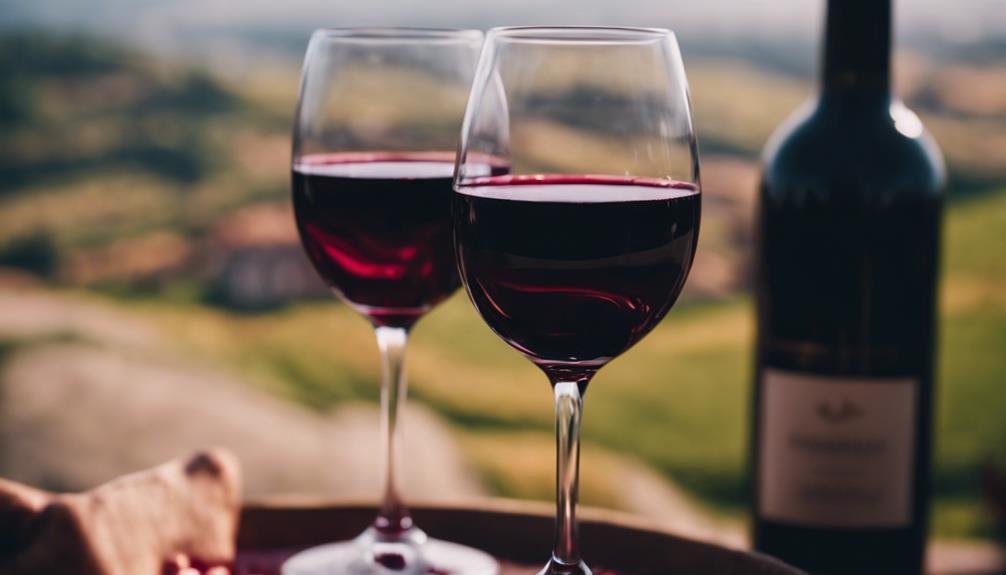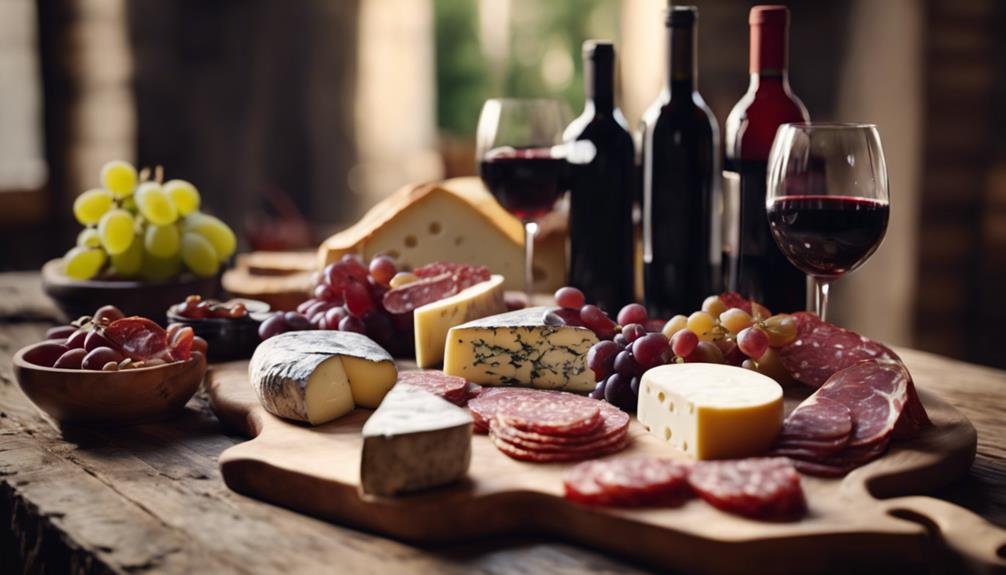Italian red wines offer a rich tapestry of flavors. Sangiovese, with its earthy tones, is a top choice, while Montepulciano boasts bold tannins. Barbera's licorice notes and invigorating acidity make it a versatile option. Nero d'Avola from Sicily exudes bold fruitiness, akin to Shiraz or Cabernet Sauvignon. Puglia's Primitivo and Negroamaro blend fruity delights well with pastas and meats. Each wine brings unique regional charm and taste profiles, promising a delightful experience for wine enthusiasts.
Sangiovese: Italys Champion Red Variety
Being Italy's champion red variety, Sangiovese boasts over 173,000 acres planted across the country and is known by various names such as Chianti and Brunello di Montalcino.
Sangiovese wines exhibit diverse characteristics based on their origin, with Tuscan variations offering earthy profiles, while those from Southern Italy present lighter, fruitier notes.
The aging potential of Sangiovese wines is notable, with the best examples reaching their peak after 4-7 years but capable of lasting even longer. This aging process allows the flavors to develop complexity and depth, enhancing the overall drinking experience.
Understanding the regional distinctions and aging potential of Sangiovese wines can lead to a more nuanced appreciation of this iconic Italian grape variety.
Montepulciano: Central Italys Bold Choice
Central Italy presents Montepulciano as a bold and distinctive red wine choice, characterized by its deep color and bold tannins. This grape thrives in Central Italy under the name Montepulciano d'Abruzzo, boasting over 75,000 acres planted.
Montepulciano wines are best enjoyed after aging for 4-7 years, with some fine examples lasting even longer. This robust wine pairs well with a variety of dishes, including rich pasta dishes, roasted meats, and aged cheeses.
Central Italy's wine regions provide the ideal climate for Montepulciano grapes, allowing them to develop their full potential. While Montepulciano is less common outside Italy, its unique characteristics and bold flavors make it a standout choice for wine enthusiasts seeking a rich and complex red wine experience.
Barbera: Piedmonts Licorice Infusion

With its unique licorice note in taste, Barbera stands out as Piedmont's most produced Italian red wine. The vineyard origins of this delightful wine can be traced back to the Piedmont region, where over 60% of the world's Barbera vineyards are located.
Here are four compelling reasons why Barbera is a standout choice for wine enthusiasts:
- Versatile Pairing: Barbera's licorice note makes it a versatile option for food pairing, especially with dishes that have a hint of sweetness or herbal elements.
- Refreshing Acidity: The wine's juicy acidity enhances its overall freshness, making it a delightful choice for various occasions.
- Tart Black Cherry Flavors: Barbera's tart black cherry flavors add a unique twist to its profile, appealing to those who enjoy fruity yet complex wines.
- Youthful Enjoyment: Best enjoyed within the first 3 years, Barbera offers a vibrant and youthful experience for wine lovers.
Nero D'avola: Sicily's Bold Elegance
Nero d'Avola, a bold and fruit-forward variety hailing almost exclusively from Sicily, offers a distinctive elegance in its flavor profile. Known as Sicily's pride, this Sicilian gem is characterized by its bold flavors and structure, making it a standout choice for red wine enthusiasts. The wine is best enjoyed after 5-7 years, allowing its complex notes to fully develop. Nero d'Avola is often compared to Shiraz or Cabernet Sauvignon, showcasing its rich and robust characteristics. Below is a table highlighting some key aspects of Nero d'Avola:
| Aspect | Description |
|---|---|
| Origin | Sicily |
| Flavor Profile | Bold and fruity |
| Aging Potential | 5-7 years |
| Comparison | Similar to Shiraz or Cabernet |
| Notable Feature | Bold flavors and structure |
Primitivo & Negroamaro: Puglias Fruity Blend

Primitivo and Negroamaro, two prominent Italian red wine grape varieties cultivated in Puglia, offer a delightful fruity blend that captures the essence of the region's winemaking tradition. Puglia's dynamic duo creates wines known for their fruity elegance, making them sought after by wine enthusiasts worldwide.
Here are four key points to understand about Primitivo and Negroamaro:
- Rich History: These grapes have a longstanding history in Puglia, where they thrive in the warm climate and fertile soil, producing wines with a unique character.
- Flavor Profile: The blend of Primitivo and Negroamaro results in wines with a medley of fruity flavors such as strawberry, raspberry, blackberry, complemented by subtle hints of leather.
- Versatile Pairing: Puglia's fruity blend pairs excellently with a variety of dishes, from hearty Italian pasta to grilled meats, enhancing the dining experience.
- Youthful Enjoyment: Best enjoyed within the first 3 years, these wines offer a vibrant and invigorating taste.
Valpolicella Blend: Venetos Signature Mix
The Valpolicella Blend stands as a distinguished representation of Veneto's winemaking tradition, showcasing a harmonious fusion of Corvina, Molinara, and Rondinella grapes. This blend, consisting of 22,000 acres in Veneto, includes renowned wines like Valpolicella Classico and Amarone, each offering unique drinking experiences.
Veneto's wine secrets are encapsulated in the diverse styles derived from this signature mix, with Amarone standing out for its intensity achieved through the partial dehydration of grapes. The Valpolicella Blend is a prime example of the unique Veneto blends that capture the essence of the region's winemaking expertise.
Whether exploring the lighter Valpolicella Classico or indulging in the robustness of Amarone, this blend embodies the rich tapestry of flavors that Veneto has to offer.
Nebbiolo: Piedmonts Respected Elixir

Piedmont's Nebbiolo stands as a revered red wine, esteemed for its regional significance and diverse expressions.
- Nebbiolo thrives in Piedmont's wine culture, where winemakers craft Barbaresco and Barolo, showcasing the grape's versatility.
- This grape variety boasts exceptional aging potential, with the best bottles reaching their prime after 7-10 years.
- Nebbiolo from hotter regions presents bold, tannic profiles, while those from the north offer delicate and tart characteristics.
- Despite its limited 12,000 acres planted, Nebbiolo remains a unique gem, less common globally than Cabernet Sauvignon.
Frequently Asked Questions
Can Sangiovese Wines From Tuscany Be Aged for More Than 10 Years?
Sangiovese wines from Tuscany can indeed be aged for more than 10 years, showcasing the aging potential of this varietal in Tuscan terroir. With proper storage conditions, these wines can evolve beautifully, offering complex flavors and aromas.
Are There Any Unique Food Pairing Recommendations for Montepulciano Wines?
When considering food pairings for Montepulciano wines, the robust flavors of this Central Italian gem complement rich dishes like hearty stews, grilled meats, and aged cheeses. Its bold tannins and deep fruitiness elevate these culinary experiences.
How Does the Licorice Note in Barbera Wines Develop During Aging?
The licorice aromas in Barbera wines develop through the aging process. Initially subdued, over time, these notes intensify as the wine matures, intertwining with the herbaceous, juicy acidity, and tart black cherry flavors characteristic of Barbera, creating a harmonious complexity.
Are There Any Specific Regions in Sicily Known for Producing Exceptional Nero Davola Wines?
Sicily boasts exceptional Nero d'Avola wines from renowned vineyards due to its unique terroir. Winemaking techniques emphasize bold flavors and structure, making Sicilian vineyards prime locations for producing high-quality Nero d'Avola wines that showcase the region's distinct characteristics.
What Distinguishes the Flavor Profile of Primitivo & Negroamaro Blends From Other Italian Red Wines?
Primitivo & Negroamaro blends stand out in Italian red wines due to their distinct fruity profiles influenced by terroir. These wines offer a balanced tannin structure and acidity, showcasing aging potential. Their flavor complexity sets them apart from other varietals.
Conclusion
To sum up, Italian red wines offer a diverse range of flavors and styles that are sure to captivate wine enthusiasts.
One interesting statistic to note is that Italy produces over 5 billion liters of wine annually, making it the largest wine-producing country in the world.
With popular grape varieties like Sangiovese, Montepulciano, and Nebbiolo showcasing the unique terroir and winemaking traditions of their regions, exploring Italian red wines is a journey worth undertaking.
